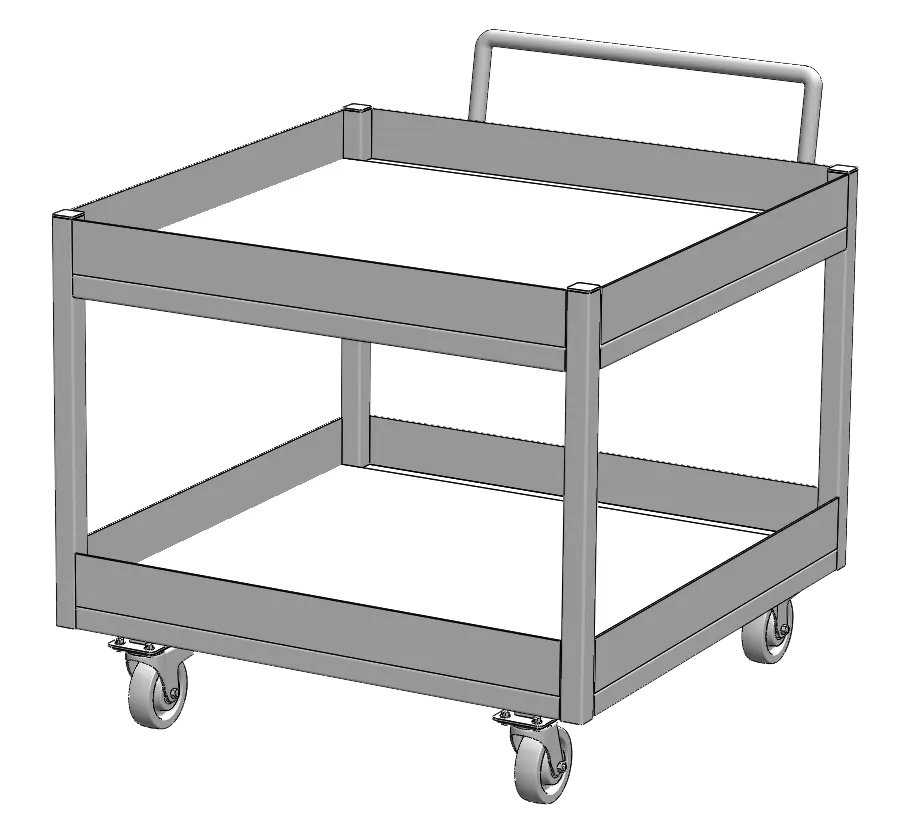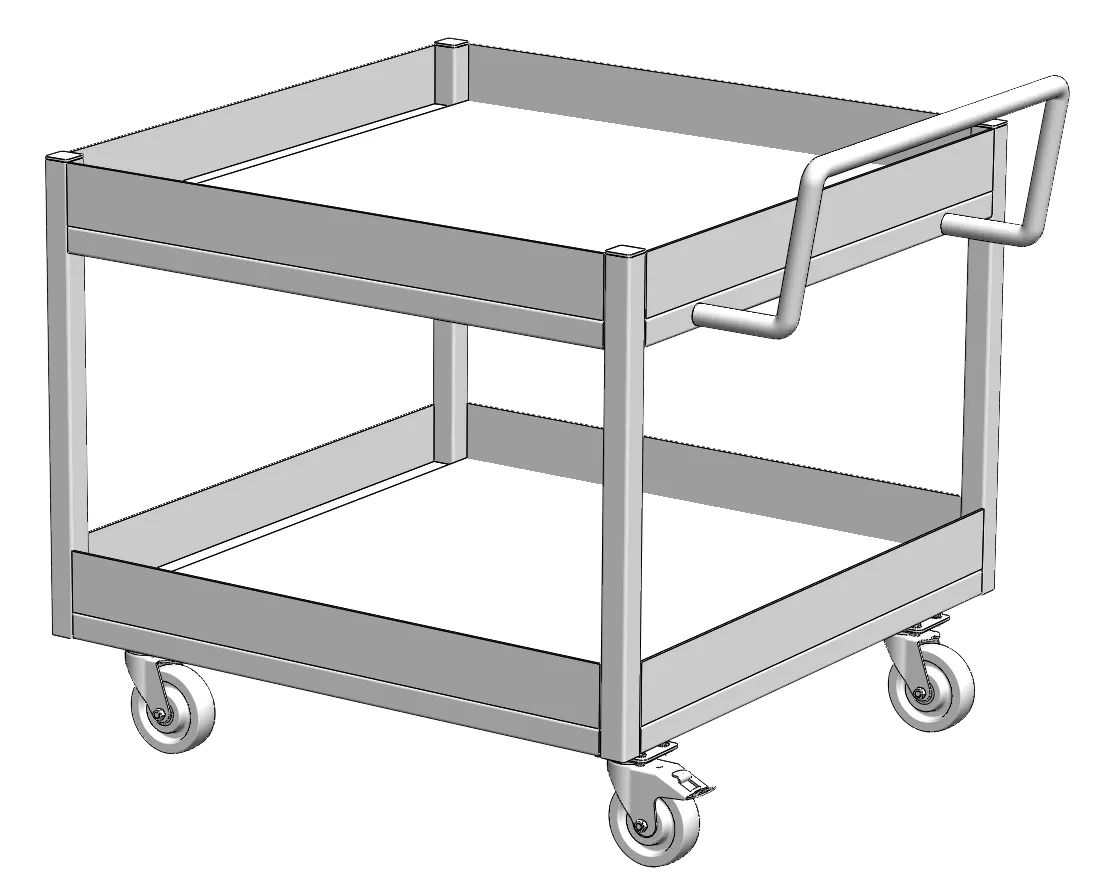What is an industrial cart?
An industrial cart, also known as a material handling cart or utility cart, is a wheeled vehicle specifically designed for transporting goods and materials within industrial settings. These carts have a sturdy construction, typically made of materials like steel or aluminum, to withstand heavy loads and rough terrains.
Industrial carts are essential equipment in various industries, providing a convenient and efficient way to transport materials and products within a workplace. Whether it’s in manufacturing plants, warehouses, or distribution centers, industrial carts play a crucial role in keeping operations running smoothly. In this comprehensive guide, we will explore everything you need to know about industrial carts, from their definition and types to maintenance tips and best practices.

Common uses of industrial carts:
Industrial carts serve a wide range of purposes in different industries. Some common uses of an industrial cart includes:
-
Material Transport: Industrial carts are primarily used for moving materials, components, and finished products within a facility. They facilitate the movement of goods from one workstation to another, streamlining production processes.
-
Inventory Management: These carts are also beneficial in inventory management, allowing for the easy storage and retrieval of items. With proper organization and labeling, carts can help improve efficiency in locating and counting inventory.
-
Waste Removal: In industries where waste disposal is a regular task, an industrial cart is used to collect and transport waste materials to designated disposal areas. Ultimately, this helps maintain a clean and safe working environment.
-
Tool and Equipment Transport: Industrial carts can also be utilized for transporting tools and equipment to different work areas. This ensures that workers have easy access to the necessary tools and reduces downtime searching for misplaced equipment.
Key features of a quality industrial cart:
When selecting an industrial cart, it is essential to consider certain features that contribute to its durability, functionality, and safety. Key features to look for in a quality industrial cart include:
-
Load Capacity: The cart should be able to handle the desired weight capacity without compromising stability. It’s important to consider both the maximum weight limit and the distribution of weight on the cart.
-
Wheel Design: The cart’s wheels should be robust and suitable for the specific environment in which it’ll be used. Factors such as material, size, and maneuverability should be taken into account.
-
Ergonomics: Look for carts with ergonomic handles, allowing for comfortable pushing or pulling. Adjustable handle heights can accommodate different operators and reduce strain.
Benefits and importance of using industrial carts
Industrial carts offer numerous benefits and play a vital role in optimizing workflow efficiency and productivity. Here are some of the key benefits and the importance of using an industrial cart in the workplace:
-
Increased Efficiency: Industrial carts facilitate the movement of materials, enabling workers to transport items more quickly and efficiently. As a result, this saves time and effort, leading to increased productivity.
-
Improved Safety: Utilizing an industrial cart to transport heavy or bulky items helps prevent injuries that may occur from lifting or carrying these objects manually. In fact, these carts are designed with stability and safety features, reducing the risk of accidents.
-
Organized Workspaces: These carts provide a systematic way of organizing materials and products. With different compartments or shelves, carts help maintain a neat and clutter-free work area, enhancing overall efficiency.
-
Versatility: An industrial cart can be used in various industries and applications, making them a versatile asset. They can adapt to different materials, products, or environments, making them highly functional in any workplace.
Overall, the use of an industrial cart promotes efficient processes, improves workplace safety, enhances organization, and contributes to a more streamlined workflow.
Types of industrial carts
There are various types of industrial carts available, each designed to cater to specific needs and requirements. To ensure you choose the right cart for your workplace, it’s essential to understand the different types and their specific applications. Here are some commonly used types of industrial carts:
-
Platform Carts: Platform carts have a large, flat platform surface and are ideal for transporting bulky or heavy items. They often come with a handle for easy maneuverability.
-
Utility Carts: Utility carts are versatile and can be used in a wide range of applications. They feature multiple shelves or compartments, offering ample storage space for different items.
-
Drum Carts: Drum carts are specifically designed for transporting drums or barrels. They have features like securing straps and wheel locks to ensure stability during transportation.
-
Tilt Carts: Tilt carts have a tilting mechanism that allows easy dumping or unloading of materials. They are commonly used in industries that involve heavy and bulky loads, such as construction or landscaping.
-
Wire Carts: Wire carts feature a wire mesh design, providing visibility and allowing for air circulation. They are commonly used in healthcare settings, laboratories, or as laundry carts.
-
Order Picking Carts: Order picking carts are designed for order fulfillment processes. They usually have multiple shelves or compartments to organize and sort items for picking and packing.
By understanding the specific features and applications of these different types of industrial carts, you can make a well-informed decision when choosing the most suitable cart for your workplace needs.

How to choose the right industrial cart for your needs
Choosing the right industrial cart for your needs involves considering various factors and requirements specific to your workplace. By evaluating these considerations, you can ensure that the chosen cart meets your expectations in terms of functionality, durability, and safety. Here are some key considerations when selecting an industrial cart:
Considerations when selecting an industrial cart:
-
Environment: Assess the environment in which the cart will be used. Consider factors such as flooring surface, space constraints, the presence of ramps or stairs, and the need for outdoor or indoor use.
-
Load Capacity: Determine the maximum weight capacity required for the cart. Consider both the total weight and the distribution of weight on the cart to ensure stability and safe transportation.
-
Mobility Requirements: Evaluate the maneuverability needs of your workplace. Assess whether you need a cart with swivel wheels for easy navigation or if straight-line movement is sufficient.
-
Ergonomics: Consider the comfort and ergonomics of the cart, especially if it will be used extensively or by multiple operators. Look for features such as adjustable handle heights and comfortable grips.
Factors to evaluate when choosing an industrial cart:
-
Material: Look for carts made of durable and corrosion-resistant materials like steel or aluminum, ensuring longevity and resistance to wear and tear.
-
Wheel Design: Consider the size, material, and wheel configuration to determine their suitability for your workplace environment. Essentially, you need to choose wheels that can handle the terrain and load capacity required.
-
Safety Features: Pay attention to safety features such as wheel locks, corner bumpers, or anti-tip reinforcements, which help prevent accidents and ensure stable transportation.
-
Customization Options: Determine if customization options are available to tailor the cart to your specific requirements. This may include adding additional shelves, compartments, or accessories to enhance functionality.
By carefully considering these factors and evaluating your specific needs, you can select an industrial cart that maximizes efficiency, durability, and safety in your workplace.
Industrial cart best practices
Implementing best practices for industrial cart usage can further enhance efficiency and safety in the workplace. Here are some best practices for optimizing the use of these carts:
1. Efficiently organizing materials:
Properly organize materials on industrial carts to increase efficiency and reduce search time. Group similar items together, use labeling systems, and arrange items in a logical order to streamline workflows and minimize errors.
2. Maximizing storage space:
Utilize the available storage space on industrial carts effectively. Use storage compartments or additional accessories like baskets, dividers, or hooks to maximize the capacity and keep smaller items organized.
3. Ensuring proper loading and unloading procedures:
Train employees on proper loading and unloading techniques to ensure the stability and safe transportation of materials. Avoid placing heavy items on top of light or fragile items, and distribute the weight evenly to maintain balance.
4. Implementing safety measures:
Promote a safety culture by implementing measures like speed limits, designated traffic lanes, or floor markings to prevent accidents or collisions. Encourage the use of personal protective equipment (PPE) and proper lifting techniques.
By implementing these best practices, you can enhance efficiency, minimize accidents, and optimize the use of industrial carts in your workplace.
Conclusion
Industrial carts are indispensable tools in various industries, contributing to efficient material handling, increased productivity, and optimized workflows. Understanding the various types, key features, and benefits of industrial carts is crucial for selecting the right cart for your workplace needs. Additionally, incorporating maintenance and safety practices, along with implementing best practices, can further enhance the functionality and longevity of industrial carts.
By considering customization options, sourcing from reputable manufacturers or suppliers, and following maintenance guidelines, you can optimize the use of industrial carts in your workplace, promoting efficiency, safety, and productivity.






